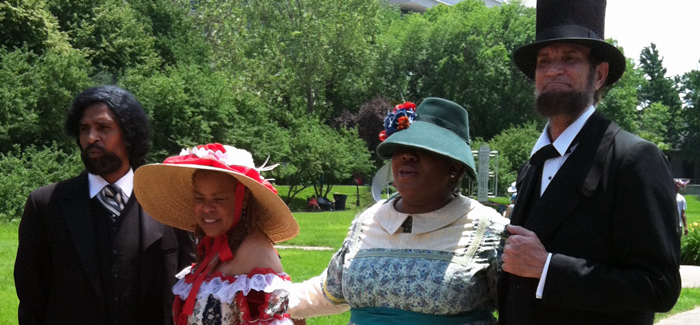
(Photography by Jeanie Chung)
Learning, or not, at the DuSable Museum’s Civil War reenactment.
Being six years old, my daughter knows everything. Thus, when I asked her what she learned from the DuSable Museum’s event “The Civil War and the Colored Soldier,” she said, “Nothing. I knew all that already.”
Which is not to say she didn’t have a good time. The highlight of the June 23 event, commemorating the 150th anniversary of the Emancipation Proclamation, was the reenactment of a skirmish between an African American Union regiment and Confederate soldiers. African Americans made up 10 percent of the Union Army, and the reenactment—a first for the museum and Chicago—was both a tribute to them and a reminder that the Civil War was not just about one group of white people fighting another group of white people over one group’s desire to enslave black people. That fact is not always obvious in children’s books.
The reenactment began slowly, with a lengthy exchange of cannon “fire,” but by the time the Union advanced, “killing” a Confederate in the process, the crowd was cheering.
“That was great!” my daughter yelled. I asked her favorite part, and without hesitating she said, “When the guy got killed!”
After a free tour of the museum, we visited the medical tent—where a reenactor talked about “recovering” from brain surgery and a bullet wound—then heard about and saw what the soldiers ate, what they carried, and how they fought. Volunteers dressed as Abraham Lincoln, Frederick Douglass, and Sojourner Truth stopped for pictures. My daughter said hello to one of the cavalry horses but declined the offered ride. Since our time was limited, we left before the second skirmish, much to her annoyance. Don’t remind her, but we forgot to go back and try out the replicas of Civil War-era musical instruments.
On the drive home, she launched a volley of questions, mostly about how the war started and which states were on which sides. Having jumped on the Blackhawks bandwagon with a vengeance and eager to vilify their opponents, she was slightly disappointed to discover that Minnesota, Detroit, Los Angeles, and especially Boston all would have been with the Union.
Similar conversations were probably taking place in cars around the area, and if the kids didn’t want to think of them as “learning,” I was OK with that, and I imagine the museum leadership was too.
